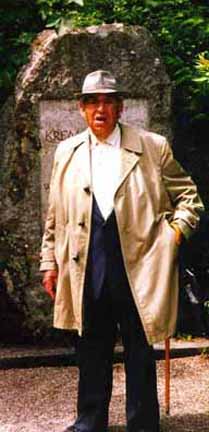Dachau Survivor Martin Zaidenstadt On my third visit to the Dachau Memorial Site in May 2003, I looked for Martin Zaidenstadt, a Dachau survivor whom I had met on my first visit in May 1997, but he wasn't there. On my second visit in May 2001, I was told by someone in the museum that Martin still comes to the camp each day to talk with the tourists, but he had been absent for a few days. Martin Zaidenstadt was born in 1911 in Jedwabne, a town in Poland that was the site of a pogrom in 1941 when the non-Jews in the town killed over 500 Jewish residents and blamed it on the German troops during their invasion of the Soviet Union. Zaidenstadt would be 97 years old if he is still alive. After Dachau was liberated on April 29, 1945, truckloads of American soldiers arrived daily to visit the museum and see the gas chamber, on the orders of General Dwight D. Eisenhower. When I met Martin Zaidenstadt in 1997, he told me that he had been coming to the camp every day for fifty years. That would mean that he began visiting the former concentration camp in 1947 while it was an internment camp for Nazi war criminals and the proceedings of an American Military Tribunal were in progress. At that time, there was a small museum in the crematorium, which had been set up in 1945 by a former prisoner, Erich Preuss, and several former Dachau inmates, who were then living in the SS garrison next to the former camp, were available to tell visiting American soldiers about the atrocities committed at Dachau. Martin allowed me to take his picture, but requested that he pose in front of the Memorial stone which is just to your right as you enter the crematoria area. Just as I snapped the shutter, he was reaching into his coat pocket for one of his cards which he gave me. The card had a rainbow on it because the camp was liberated by the 42nd Rainbow division of the US Seventh Army. Martin told me that he had been a prisoner at Dachau for three years before the camp was liberated. That means that he arrived some time in the Spring of 1942, just after the Nazis began rounding up the Jews in February 1942 and sending them to the death camps in what is now Poland. For some unexplained reason, Zaidenstadt was sent to Dachau instead, so he escaped the gas chambers of Auschwitz, Majdanek, Treblinka, Sobibor and Belzec and the gas vans at Chelmno. Martin speaks several languages, including English. He used to hang out near Baracke X, the gas chamber building, where he would tell visitors that the gas chamber was used to murder prisoners in the Dachau concentration camp, although for some unexplained reason, he managed to avoid the gas chamber for three years. On the day that I met him in 1997, I approached him because he was upset after a group of Americans had rudely brushed him off after he tried to tell them about the shower room being used as a gas chamber. When I visited Dachau in May 1997 and again in May 2001, there was a portable sign in the gas chamber which informed tourists in five languages that the room had never been used for gassing. In May 2003, that sign had been removed and a new sign at the south end of the gas chamber building read as follows: "Baracke X erected May 1942 to April 1943. It was to serve both as a killing facility and to remove the dead, but the gas chamber in the middle of the building was not used for mass murder. Survivors have testified that the SS did, however, murder individual prisoners and small groups here using poison gas." Timothy W. Ryback wrote a book entitled "The Last Survivor: In Search of Martin Zaidenstadt" in which he claims that he checked the prison records at the Dachau Museum and couldn't find Martin's name among the list of prisoners who had been incarcerated there. Return to Table of ContentsHomeThis page was last updated on May 26, 2008 |